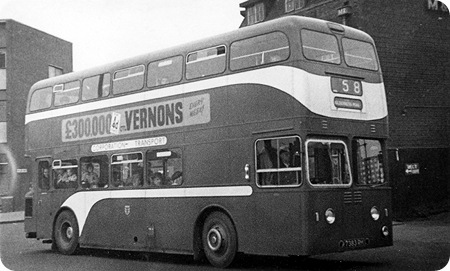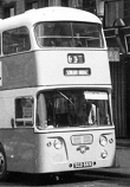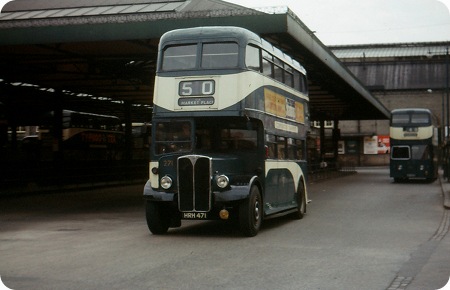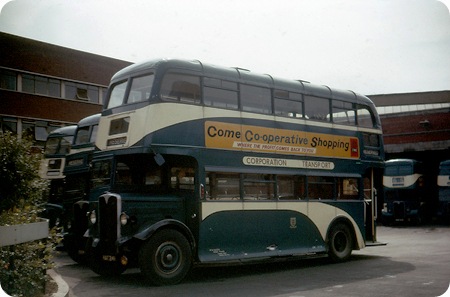
Photograph by ‘unknown’ if you took this photo please go to the copyright page.
Kingston upon Hull Corporation Transport
1963
Leyland Atlantean PDR1/1
Roe H44/31F
I could say here is a rather poor shot, not too bad at the front of the vehicle faded out and slightly grainy to the rear, or alternatively, I could say this photo was taken on a cold misty morning in March and what an atmospheric shot it is. I will let you decide which is true, I though have the advantage of seeing the original Black & White photograph.
By 1963 most operators were either switching over to rear engined vehicles or were seriously thinking about it.
C H Roe were always known for a more rounded look to their bus bodies but this vehicle is somewhat strange for one of theirs. Very square front and a flat split windscreen, which is very boxy compared to the one to the right. An Alexander bodied vehicle of the same date, a much more rounded appearance a one piece wrap round windscreen and upper deck front window, I think are much more pleasing on the eye. Both of these Atlanteans being PDR1/1s would have had a flat lower deck floor until the rear axle when there would either be a slope or a step to get over it. The PDR1/2 which arrived on the seen in 1964 had a flat floor over and to the rear of the rear axle this was made possible by the use of the Albion Lowlander rear axle.
C H Roe were known for their high quality timber frame bodies and after their take over by Park Royal they did such work and Park Royal concentrated on metal framed designs. During the fifties there was more call for metal frames and Park Royal needed to send some of its work for Roe to do using Park Royal frames – famously the Yorkshire Traction Leyland Tiger rebuilds.
When the Leyland Atlantean was introduced, Park Royal designed a body for the whole group to produce – not unlike the front entrance Bridgemaster, but stretched up to full height. The Bridgemaster was Park Royal’s ugliest design to date, but the Atlantean body excelled in ugliness – looking totally unbalanced. Some wag called them glazed pantechnions!
Park Royal was so involved in mass Routemaster production that all bodies of this design were produced at Leeds. Luckily Park Royal/Roe went on to produce the classic design introduced in quantity in 1968 which essentially continued until the end of Atlantean production.
The Alexander body is actually of a later vintage, the contemporary (first) version being differently ugly. Sheffield had a Motor Show, and unique, example (369). Unsurprisingly Glasgow and Northern General were operators of numbers of these – as was Godfrey Abbott, then a North Cheshire independent, later to be swallowed up by SELNEC.
David Oldfield
Park Royal bodied Atlanteans are so ugly, that they are beautiful, or has time rewritten every line?
Keith Easton
I think in this case I’d rather say "The combination of boxy shape and streamlined livery is so insane that it’s beautiful."
Peter Williamson
Like a streamlined brick!
Stephen Ford
Try this, then: the first Atlanteans all looked like that: the appearance of the body was dictated by its function, as fitted the taste of the times. The bustle was practical because it gave fullest access: the body could easily be repaired: "streamlining" and flashy paintjobs (Hull) were rather vulgar and reminded you of Seagulls and those funny 50’s coaches with a rudder at the top back (who by?) and GM cars. Very unsixties.
Then came the Liverpool Atlanteans & every local Councillor wanted a fleet like that…..
Joe
The 50s rudder was, of course, the Harrington Dorsal Fin – which, at the risk of being lynched, I personally thought looked ridiculous.
David Oldfield
Useful for stability at speeds over 45mph. The Russians liked them… or at least I recall some lookalikes in Moscow in the 1980’s. Go well with a ZIL!
Joe
I worked on the Atlantean buses as a conductor and driver. They where good buses in their day. I worked on the bus at top of this page on many occasion. This service bus changed from a 58 to a 55 circular bus, on some of them I nearly had to stand up to drive the bus round tight corners.
Mr Wright
I agree wholeheartedly with Mr. Wright about heavy Atlantean steering. My experience of this extended to the first examples of 33 feet long Atlanteans with no power steering and 78 seats. We had a large batch of these at Leeds City Transport and, particularly when fully loaded which they often were, it was practically necessary to stand up on tight manoeuvres to turn them – and I am nearly six feet tall. They really were a health and safety risk from that point of view. Also I’m sad, as a devoted Daimler Fleetline lover, to have to admit that the non power assisted 33 foot examples of that make were similarly unacceptable. I once had the embarrassment during a morning peak period of failing to get one of the latter round a temporary hairpin bend in Hunslet – the bus was fully loaded with some ribaldly outspoken clients and their remarks as I literally stood up in the cab to heave it through multiple "shunts" ring in my ears to this day, forty years later.
Chris Youhill
I have to say I agree wholeheartedly with Chris Youhill that the Daimler Fleetline was a nicer bus to drive than the Atlantean. In addition to his comments about heavy steering, early ones were anything but smooth to move from rest with a full load. It wasn’t necessary for the conductor to ask standing passengers to move down inside; the transmission would make sure of that as the vehicle started to move! The appeal/functionality of the ‘bustle is a matter of opinion; the Fleetlines I knew didn’t have them, and, (admittedly for many other reasons), the engineers I worked with found them better vehicles to maintain.
As far as the bodywork is concerned, I recall early lowbridge Atlanteans at Maidstone & District had a semi-offset gangway upstairs; central until about the last three rows of seats and then to the side. I rather think they had Weymann bodies. The flat front was a major reason for M&D to decide on Atlanteans, since they were introduced originally as replacements for the trolley buses in Hastings.
Roy Burke
I hope I’m not going to start disagreeing with Chris Y – we seem to agree on everything else.
Well actually, I don’t disagree! Everything he and Roy have said is absolutely true. They were rubbish, especially when compared with the PD2 and PD3 and Leyland didn’t get it right until the AN68 – when they ended up with the best of the first generation rear-engined deckers. [Of course, the AN68 did benefit by having power-steering and the 0.680 as standard.]
As we’ve said before, Metro-Cammell (MCCW) and Weymann were separate companies with a common marketing company (MCW). Often there were hidden side effects to this, not generally known. One concerned early Atlanteans. MCCW were the bigger "half" and dealt with big runs. The smaller Weymann would deal with smaller runs and more specialist work – including coaches. All early highbridge Atlanteans had Met-Camm bodies and all semi-highbridge bodywork was by Weymann.
This was to get more muddied later on. [Weymann built at least two, small, batches of highbridge for Sheffield Transport in 1962/3.]
David Oldfield
Roy’s mention of Atlanteans replacing the Hastings trolleybuses takes me back to very happy teenage years as a frequent visitor to the resort. As if the modern trolleybuses weren’t magnificent enough the wonderfully evocative fleetname at the time was the icing on the cake – "Hastings Tramways Company." Also any pretentious ideas the Council may have had about their beautiful and impressive Promenade were chopped down to size by the trolleybus destination blinds, where the lovely bracing thoroughfare was referred to as "Front."
David, please never fear about disagreement on any topic at all, as the opinions and knowledge of qualified friends are always most welcome.
Chris Youhill
05/08/16 – 06:00
Split window Atlantean terrible bus, draughty loose front window, noisy air driven w/s wiper, cold demisters and heaters, great holes in the floor for pedal, h/b rubber wouldn’t stay down, rigid drivers seat bolted to the floor with minimum cushioning situated five feet in front of the wheels giving a springboard effect if you were on a rough road, plastic peeled off the steering wheel leaving an alloy surface (hell in winter). Front wheels slid away on a wet surface you had to put your foot on the console to get it round a sharp bend, with Insp. Chris Hudson spraying deicer on the INSIDE of the w/s as you pulled out of Ferensway station. I’m sure there’s more but it’s been 35 years since I left.
At least they didn’t suffer from fuel surges or power steering failure going round corners like Scania’s
Pip
05/08/16 – 13:58
Going back to David Oldfield’s first post, above, Glasgow only had the one square-bodied Atlantean/Alexander (LA1), and Godfrey Abbott only had secondhand Atlanteans and Fleetlines, since running double-deckers on predominantly schools services was very much a latter-day experience for them. The only square-bodied Atlantean/Alexander I have managed to connect with them is KCN182, new 1/60 to Gateshead & District. They may have had others.
David Call
05/08/16 – 13:58
How long did the "streamlining" livery last and was that to the end of Hull Corporation’s existence?
Chris Hebbron
07/08/16 – 07:07
Chris,
The ARH-K batch of Atlanteans were the first in the non-streamlined livery that lasted from 1972 to the Cleveland Transit buy-in (c.1989) and then in a version with Yellow relief added to the Stagecoach takeover in c. 1995.
Stephen Allcroft
07/08/16 – 07:07
The streamline livery started to disappear from 1972, when Atlantean 318 (DRH 318L) appeared on the Commercial Motor Show in 1972, with a new Blue and White livery and the fleetname Kingston upon Hull City Transport, this was previewing the local government reforms of 1974, when Corporations were abolished, new vehicles from 1972 appeared in the new livery (slightly different from 318)and old ones embarked on a repainting programme.
Keith Easton
08/08/16 – 06:56
Steve/Keith – Thx.
Chris Hebbron
09/08/16 – 06:14
Further to my earlier comment the repainting was largely complete by 1975 (which was when I really got interested in Hull buses); all vehicles except for the AEC Reliances and the early Atlanteans mainly the 346-95 batches. Consequently the streamline livery finally disappeared from the streets of Hull around 1980.
Keith Easton
10/08/16 – 05:54
Thx, Keith. This must have been the last operator to use the streamline livery principle by a country mile, I’d wager. In fact, how many operators used streamline livery? Being a Southerner, the only one which immediately comes to mind, apart from Hull, was Manchester, Sheffield, Rochdale and, after a fashion, Blackpool Corp’n, but there were others, I suspect.
Chris Hebbron
21/08/16 – 07:44
Hello Stephen, Sorry to have to correct you, but the DRH-L batch, delivered 12/72 were the first to be delivered in the new livery, with 318 in the prototype livery being repainted later to match the remainder of the batch. The earlier batch ARH298-317K were delivered across the new year 1971/2 and were the last to be delivered in the streamline livery, indeed I have photographs of 310 and 313 still in streamline livery in May 1975.
Keith Easton




